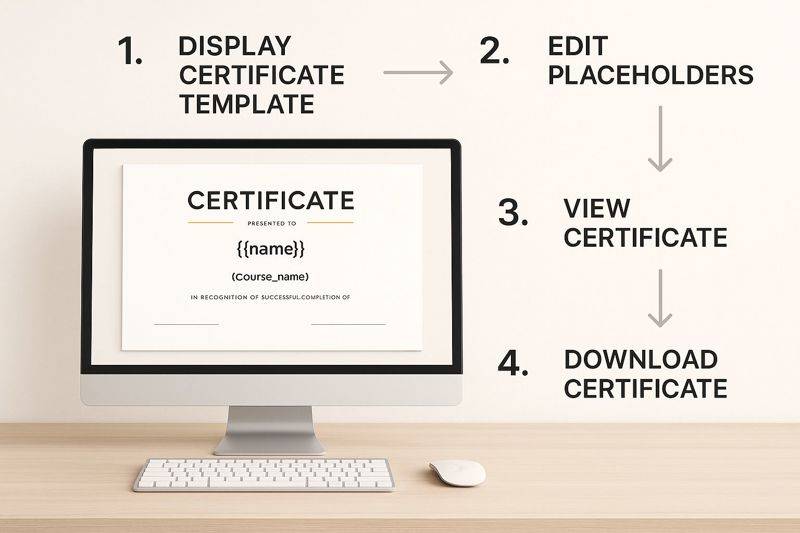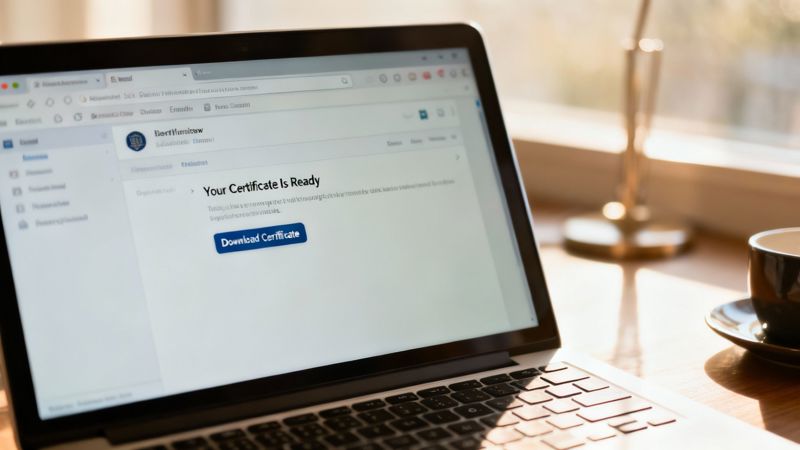Making a certificate isn't just about slapping a name on a template. It's about creating a valuable, verifiable credential that represents a genuine accomplishment. With a tool like OKZest, you can ditch the static PDFs and connect professional designs to your data sources, letting you create and send personalized certificates for every single recipient, instantly.
Why a Thoughtful Certificate Matters More Than Ever

In a world full of fleeting digital noise, a well-crafted certificate actually means something. It's a tangible symbol of achievement that stands out. It’s no longer just a piece of paper or a simple PDF; it’s a powerful branding asset and a huge motivator for your students, employees, or community members.
That feeling of receiving a certificate reinforces the value of their hard work and deepens their connection to your organization. This isn't just a feel-good thing; it has a real-world impact. When someone proudly shares their new credential on LinkedIn or shows it to their manager, your brand gets a boost in credibility and visibility. Every detail—from design to delivery—is a chance to make a lasting impression.
The Four Pillars of a Valuable Modern Certificate
To create a certificate that truly resonates today, you need to focus on four core components. A breakdown of these essentials transforms a simple document into a credible and respected credential.
| Pillar | Why It's Crucial | Real-World Application |
|---|---|---|
| Professional Design | First impressions count. A clean, branded design immediately signals quality, professionalism, and legitimacy. | A certificate from a tech bootcamp that mimics the clean UI of a modern app feels more authentic and valuable. |
| Verifiable Credentials | Authenticity is everything. People need a way to easily confirm the certificate is genuine, usually through a unique link or QR code. | An employer can quickly scan a QR code on a digital certificate to confirm a candidate's qualifications. |
| Accurate Personalization | Generic awards feel cheap. Using dynamic data for the recipient’s name, course, and date makes the achievement feel specific and earned. | Instead of "Certificate of Completion," it reads "Awarded to Jane Doe for Mastering Advanced Python on October 26, 2024." |
| Seamless Delivery | Don't make them wait. Instant, automated delivery via email or a web portal makes the experience smooth and rewarding right when their motivation is highest. | A student completes a final quiz and immediately receives an email with a link to their personalized certificate. |
Get these four pillars right, and you're not just sending a file—you're delivering a meaningful recognition of effort and skill.
The growing importance of these documents is clear across industries. The global certificates market was valued at around USD 5.50 billion in 2023 and is projected to hit nearly USD 8.00 billion by 2030, which shows just how vital they've become in professional and environmental sectors. You can explore more certificate market growth insights on Maximize Market Research.
Designing a Certificate That Looks Professional
First impressions matter. A certificate’s design is the very first thing that signals its value. If it looks sloppy or generic, it instantly undermines the achievement it's supposed to represent. On the other hand, a polished, professional design commands respect and credibility. The good news is, you don't need to be a graphic designer to create one—it’s all about making thoughtful choices within a tool like OKZest's builder.
Let’s start with the foundation: the background. My advice? Steer clear of busy, distracting patterns. A clean, subtle background, perhaps using your brand’s primary or secondary colors, always works best. It creates a professional canvas that lets the important information shine. If you need some ideas, our guide on selecting the right images for certificates is a great place to start.
Next up, your logo. Make sure you upload a high-resolution file, ideally a PNG with a transparent background. Nothing cheapens a document faster than a blurry, pixelated logo. Position it somewhere prominent but not overpowering—the top-center or top-left is usually a safe bet.
Building a Balanced and Dynamic Layout
Once your branding elements are in place, it's time to think about the text layout. The goal here is balance, not clutter. Give the design some breathing room by using plenty of whitespace—that's the empty area around your text and logo. This negative space is what guides the eye and creates that feeling of sophisticated simplicity.
Now for the really powerful part: dynamic elements. Instead of manually typing out every single person's information, you'll use placeholders, which we call "smart fields." These are just simple text snippets that OKZest will automatically fill in with data from your spreadsheet or database.
{{name}}for the recipient's full name.{{course_name}}for the title of the course or program.{{completion_date}}for when the achievement was earned.
This infographic gives you a clear picture of how these placeholders fit into a finished template.

As you can see, a clean layout combined with balanced typography and these dynamic fields creates a template that’s ready for full automation. This is how you ensure every single certificate is both professional and perfectly personalized.
Final Touches for a Credible Design
Don't underestimate the impact of typography and color. Choose one or two professional fonts—maybe a bold, elegant one for the recipient's name and a clean, readable one for the rest of the text. And, of course, stick to your brand's color palette to keep everything consistent.
A great certificate isn’t just designed; it’s engineered. Every element, from the font choice to the use of dynamic placeholders, should work together to build a sense of legitimacy and pride for the recipient.
To make sure your digital certificates not only look great but are also easy to understand, it helps to apply some solid web design best practices. Principles like visual hierarchy and user experience are just as relevant for a digital document as they are for a website. When you pay attention to these details, you create a certificate people will actually be proud to share.
Connecting Your Data for Instant Personalization
A great-looking template is just the start. The real magic happens when you connect it to a data source, turning a static image into a dynamic, automated powerhouse. This is the step that saves you from the soul-crushing work of manual data entry, prevents embarrassing typos, and frees up countless hours.
Think about it. You could probably manage certificates for a one-off workshop with 50 attendees by hand. But what happens when you’re running a monthly webinar with hundreds of people? Automation isn't just a nice-to-have; it's essential. This is where you map your data—like names, course titles, or completion dates—directly to the dynamic {{placeholders}} you set up in your OKZest template.
Choosing Your Data Source
You don't need a complex database to get started. Often, the simplest solution is the best one, and the right choice really just depends on your specific needs.
- CSV or Excel File: This is perfect for one-time events, like a conference or a specific course cohort. Just export your attendee list, upload it, and you're good to go.
- Live Google Sheet: An ideal choice for ongoing programs. As you add new names to the sheet, OKZest can generate their certificates automatically in real-time. It's a completely hands-off workflow.
A marketing agency, for instance, could easily upload a CSV of clients from a recent workshop. On the other hand, an online educator with an evergreen course would find a live Google Sheet to be a game-changer for their workflow.
The goal is to create a seamless bridge between your information and your design. When done right, you can generate thousands of unique, personalized certificates with the same effort it takes to make just one.
Advanced Automation with API Integration
For those who need to bake personalization directly into their existing software, connecting via an API is the way to go. This lets your own systems—like a Learning Management System (LMS) or custom CRM—"talk" to OKZest automatically. When a student completes a course in your LMS, it can instantly trigger a new certificate, all without you lifting a finger.
If you're ready to explore that, our API integration tutorial gives you a clear path forward.
This kind of automation is part of a much bigger trend. The global Certificate Authority market, which is all about authenticating digital identities, was valued at USD 188.91 million in 2024 and is projected to hit USD 628.4 million by 2035. This points to a massive industry shift toward secure, scalable, and automated credentialing. You can discover more insights on this market's growth.
Choosing the Right Delivery Method

Creating a beautiful, personalized certificate is a huge step, but it delivers zero value until it’s in your recipient’s hands. The way you get it to them is just as crucial as the design itself. This is your final touchpoint, the moment that solidifies their feeling of accomplishment.
Two strategies really stand out for smart, scalable distribution: letting recipients generate their own certificates with a self-service form or reaching them directly through personalized email campaigns. The best choice really depends on your specific workflow and audience.
Embed a Form for Instant Self-Service
Imagine a student finishes their final online quiz. Instead of waiting for an email, they're immediately taken to a page on your site where they can type in their name and email to generate their own certificate on the spot. That instant gratification is incredibly powerful, and it cuts down on your administrative work.
With OKZest, you can embed a simple certificate generation form right onto any webpage. This is perfect for places like:
- Post-quiz confirmation pages: Reward their success the moment it happens.
- Course completion dashboards: Let users claim their credential right from their learning hub.
- Webinar thank-you pages: Give attendees an immediate takeaway for their time.
This self-service approach puts the user in control, creating a seamless and satisfying experience. It also helps ensure you collect accurate information, since the recipient enters their own details.
Deliver Certificates with Personalized Email Campaigns
For a more direct, personal touch, email is still one of the most effective ways to go. When you integrate OKZest with your data source, you can automatically send a unique, personalized certificate link to each person as soon as they qualify.
A great delivery email does more than just share a link; it reinforces the value of the achievement. Frame the certificate as a testament to their hard work and encourage them to share it on professional networks like LinkedIn.
Your email's subject line is absolutely critical here. Skip the generic "Your Certificate is Ready" and try something more celebratory like, "Congratulations, [Name]! Your [Course Name] Certificate is Here."
Inside the email, make sure you have a clear call-to-action button that links directly to their unique, verifiable certificate page. This unique link is vital—it adds a layer of security, allowing employers or peers to confirm the credential's authenticity with just a click. For more inspiration on streamlining your process, you can explore ideas from our free certificate generator guide, which touches on effective creation and distribution.
Pro Tips for More Impactful Certificates
So, you've nailed the basics of creating and delivering personalized certificates. Now, let's look at a few ways to really make them stand out and add some serious value. These aren't just nice-to-haves; they transform a simple credential into a powerful tool for marketing and verification.
A fantastic starting point is adding a QR code. Instead of being a static, dead-end document, a QR code can link directly to a unique, public verification page. Imagine an employer scanning a certificate with their phone and instantly seeing a page confirming the holder's credentials. It's a simple addition that adds a massive layer of trust and legitimacy.
Another thing I see people get wrong all the time is using low-quality brand assets. A blurry logo or pixelated seal completely undermines the certificate's perceived value. Make sure your logo and any other graphics are crisp and professional, whether they're being viewed on a screen or printed out. It makes a world of difference.
Supercharge Your Workflow with Automation
For maximum efficiency, you can set up automated workflows that trigger certificate generation without you lifting a finger. This is where a tool like Zapier comes in handy, connecting OKZest to the other platforms you already use.
Think about these scenarios:
- Connect to your LMS: A student passes their final exam, and bam—a certificate is automatically generated and lands in their inbox.
- Link with your CRM: A client completes their onboarding process, and they immediately receive a "Certified Partner" certificate.
- Integrate with event platforms: As soon as an attendee checks into your webinar, their proof of attendance is created.
This level of automation doesn't just save you a ton of time. It also delivers a consistent and immediate reward to the recipient, capitalizing on that moment of achievement when they're most excited.
By turning certificates into marketing assets, you empower recipients to become brand advocates. Their success becomes your success, amplified across professional networks.
This shift toward digital verification isn't happening in a vacuum; it mirrors a much broader trend in web security. As of mid-2025, over 305 million SSL certificates were detected on websites globally, showing just how mainstream secure, verifiable digital protocols have become. You can dig into more of these security trends and their growth over on SSLInsights.com.
If you want to dive deeper into creating powerful digital documents, exploring how to implement digital customer loyalty cards can also offer some really smart, transferable strategies.
A Few Common Questions We Hear About Certificates
When you're diving into creating certificates, a few technical questions tend to pop up again and again. Getting these details right from the start will save you a ton of hassle and make sure the final result looks polished and professional.
What’s the Best Format for a Certificate Design?
Hands down, PDF is the way to go. It’s the universal standard for a reason.
For the design itself, make sure any elements you use—like your company logo or official seals—are high-resolution PNG files, ideally at 300 DPI. This is a small detail that makes a huge difference, ensuring your certificate looks crisp and sharp whether it's viewed on a screen or printed out.
Can I Set Up Automation for an Ongoing Course?
Absolutely, and this is where the real magic happens. If you have a course that's always enrolling new people, you can connect your certificate template to a live Google Sheet. Just add a new graduate's name to the sheet, and their certificate can be generated and sent out automatically. It’s that simple.
For a more seamless workflow, you can even use an API to connect your template directly to your Learning Management System (LMS). This creates a truly hands-off process.
The best certificates aren't just pretty documents; they're secure and verifiable. By giving each one a unique link, you turn it into a trusted, fraud-proof credential that holds real weight and adds value for the person who earned it.
Ready to create, automate, and deliver certificates that people are proud to share? Get started with OKZest today and see just how easy it is to personalize at scale. Learn more at https://okzest.com.